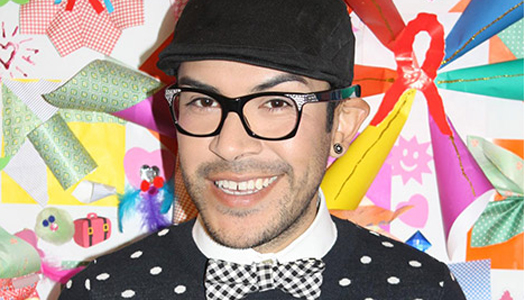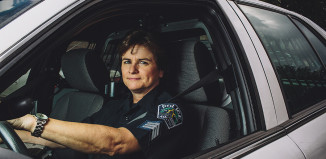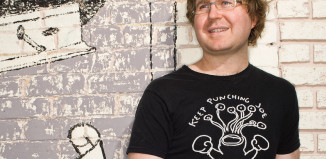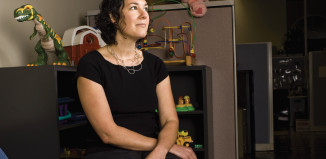You may remember Mondo Guerra from his dual appearances on Project Runway in recent seasons. He finished second his first time around and ended up winning Project Runway: All Stars during his second appearance on the show. In both seasons Guerra was known for using loud prints and bright neon colors to symbolize his HIV-positive status, which he boldly revealed to the world on an episode of Runway. In addition to pursuing his design projects, Guerra currently works as an HIV/AIDS activist and uses design to communicate awareness. He is planning to reveal a new HIV-awareness-inspired dress on World AIDS Day on December 1. Guerra is also the face of Merck’s Project I Design, an online project that that pairs HIV/AIDS awareness with interactive design elements. We chatted over the phone about his personal struggle with HIV, his projects and where he draws his inspiration.
Project I Design has users create custom art while simultaneously learning about HIV and wellness. Can you talk a little bit about how design can help someone who has been diagnosed with HIV?
For me, it was really intimidating when I walked into a clinic. It’s usually a lot of information—very clinical, very black and white—so I thought it was very important for the website to make the information very accessible. With Project I Design’s design app, it’s important for people to feel like they’re a part of something. When you create a textile, you can upload it and share it. People are realizing you’re contributing, and it’ll spark somebody else’s interest to visit the website.
 Did you ever imagine yourself having this role as an activist?
Did you ever imagine yourself having this role as an activist?
No, because for a long time I was really allowing HIV to define who I was as a person. I wasn’t living in complete honesty. I don’t think of myself as an expert or an educator—all I do is tell my personal story and hope that it encourages or inspires somebody that might be in a similar situation to start talking. When I walked that runway and that episode aired, I got such an outpouring of support. It was support from the HIV community, it was support from the fans, it was support from my family, and that really told me that I wasn’t alone. I kind of took that response and it became a responsibility for me to lend my visibility to a very important cause, which is HIV/AIDS education and advocacy.
How has your message has been received?
Whether I’m speaking to 400 people or 20 people, I know that those people are listening. It’s always really important for me to remind them to take one piece of information that I talked about today and tell someone who might not know. I’ve found in my life—because I kept my HIV-positive status a secret for 10 years—that when I was able to apply my honesty and speak my truth, it has lent itself to everything in my life, in my relationships, in my art, my creative life, in my business life, in this advocacy work. It’s just amazing the power of honesty and truth, and it’s been amazing how many people are willing to be honest and truthful with you. That’s why I love to travel the country—I get to hear everybody else’s story who is affected by the disease.
You revealed that you’re HIV-positive on camera. Did this announcement affect your design?
I never considered myself a fashion designer, I considered myself a creator. I’m always inspired by so many different things, so it really took a while for me to understand really what my point of view was. I put so much of my emotions into the content of my garments. It was amazing for me to see that Heidi, Tim, Nina and Michael really responded to my kooky kind of point of view. I don’t think that I, as a creative person, ever really changed. As an artist it’s always a process and we develop. When I design, I participate in my creative life, but I also have to participate in my healthy life to be able to move forward.
You’ve designed for both runway and theater. Which do you prefer?
I started out in theater in Colorado as a stitcher and a crafter. I love being backstage, so then I had the opportunity to design for two productions: I did Hairspray and I also did Legally Blonde. If you’re working on the right show, you can really blend that idea of fantasy and belief…I feel more like a kindred spirit when I’m creating costumes. I mean, I do that with my patterns and I do that with my fashion, and definitely on runway shows I can go over the top. Since there’s a consumer and they’re buying fashion versus a costume, sometimes you have to pull back a little bit to make sure the consumer understands it. When it’s on the stage, they’re there to see a show, so you should give them something that they’re like “What the?”
How do you keep it all together? It feels like you’re doing a million things at once.
I just have to take it day by day. I do wear several different hats that are all very special to me. The beauty about having this disability is that I’m able to pick my projects. The hardest thing about it is learning how to say “no” to certain projects. There’s a saturation of things that are going on right now, and, you know, it can sometimes be stressful and you sometimes feel that you’re being stretched too thin, but I really do enjoy it. It really is a lot of planning and a lot of deep breathing.
You’re based out of Colorado, which seems laid-back in comparison to, say, Vegas or New York City. How do you transition from private Mondo to public Mondo?
It does affect me because it all happens so quickly: it went from zero to one hundred in a matter of a month or two. The way I handle it is I know where I came from. I know that I was baptized in the same church where my grandfather is still an usher, that all my family has gotten married in. And when I’m having a bad day, I know that I’ve always been taught to be very grateful for every opportunity. All these things that are on my plate right now? I don’t expect anything in return. I do them because I want to, because I’m passionate about them. They’re all opportunities.




































